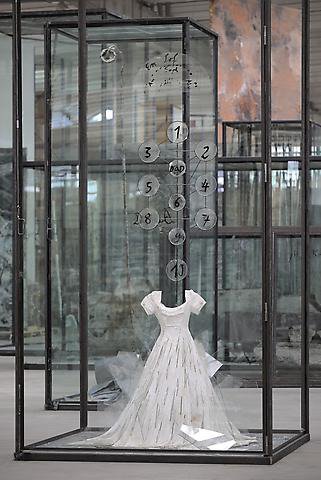Anselm Kiefer
dal 5/10/2010 al 17/12/2010
Segnalato da
5/10/2010
Anselm Kiefer
Gagosian Gallery, New York
The title of the show invokes an utopian refrain from the end of the Passover Seder. The exhibition centers around the installation Occupations, which transforms Kiefer's provocative series of photographs in which he appears making the Nazi salute. Seventy-six newly printed photographs are mounted first on lead, then on burlap shrouds, within a partially enclosed steel container. In this imposing structure, which offers multiple points of entry, each photograph becomes a translucent scrim where the image is barely legible.

"There is a special border, the border between art and life that often shifts deceptively. Yet, without
this border, there is no art. In the process of being produced, art borrows material from life, and the
traces of life still shine through the completed work of art. But, at the same time, the distance from
life is the essence, the substance of art. And, yet, life has still left its traces. The more scarred the
work of art is by the battles waged on the borders between art and life, the more interesting it
becomes."
Anselm Kiefer
Gagosian Gallery is pleased to present “Next Year in Jerusalem,” Anselm Kiefer’s first exhibition in
New York since 2002.
“Next Year in Jerusalem” invokes an utopian refrain from the end of the Passover Seder, a Judaic
tradition that idealizes a return to Israel where all believers can celebrate the rites of renewal.
The exhibition centers around the installation Occupations, which transforms Kiefer’s provocative
series of photographs from 1969 in which he appears making the Nazi salute (Hitlergruß) in front of
European sites of historical significance. Seventy-six newly printed photographs are mounted first
on lead, then on burlap shrouds, within a partially enclosed steel container. In this imposing
structure, which offers multiple points of entry, each photograph becomes a translucent scrim
where the image is barely legible. With this unprecedented new form, Kiefer integrates, expands,
and regenerates imagery and techniques from earlier phases of his oeuvre.
Kiefer has transformed the space that surrounds Occupations into a labyrinth of glass and steel
vitrines, some more than twenty feet high. Each vitrine is a tableau of organic and inorganic
material -- cotton dresses, palms, bushes, an airplane fuselage, and burned books. They appear like
ancient reliquaries with titles inscribed directly on the glass. In these works, Kiefer inverts the
historical and ritualistic connotations of his chosen materials, particularly lead. In Valentinus, named
for the second century Gnostic theologian, lead buckets and chains are juxtaposed with synthetic
diamonds and wire; in Sefiroth a disembodied white dress is molded to an invisible female figure and
surrounded by glass shards and numbered glass disks, in reference to one of the ten Kabbalistic
markers of spiritual presence.
In large paintings hung around the perimeter of the gallery, Kiefer has collaged photographs and
other elements to canvas, integrating diverse landscapes including mountains, sea and forest. In
Mount Tabor, barren fields lead to the site of Christian pilgrimage where the Transfiguration is said
to have occurred. Entrance to Paradise comprises four panels encased in glass and steel that contain
lead and fragments of thornbush on canvas. The cumulative effect is one of a mythical refuge or
forest where materials are recast as transcendent elements on an epic scale.
Kiefer's monumental archive of human memory gives overt material presence to a broad range of
cultural myths and metaphors, from the Old and New Testaments to the Kabbalah, from ancient
Roman history to the poetry of Ingeborg Bachmann and Paul Célan. By constructing elaborate
scenographies that fuse art and literature, painting and sculpture, Kiefer engages the complex
events of history, the ancestral epics of life, death, and the cosmos, and the fragile endurance of the
sacred and the spiritual amid the ongoing destruction of the world.
The exhibition will be accompanied by a fully illustrated catalogue with an essay by cultural
historian and novelist Marina Warner and Anselm Kiefer’s own writings.
Anselm Kiefer was born in Germany during the last year of World War II. After studying law, he
began his art education in Karlsruhe and then Düsseldorf, where he met Joseph Beuys. His work has
been shown in and collected by major museums throughout the world. Recent retrospective
exhibitions include the Modern Art Museum, Fort Worth (2005) (traveling to the Musée d'art
contemporain de Montréal, the Hirshhorn Museum and Sculpture Garden, Washington, D.C., and SF
MOMA). In 2007, the Guggenheim Museum Bilbao presented an extensive survey of recent work and
Kiefer was commissioned to create a huge site-specific installation of sculptures and paintings for
the inaugural "Monumenta" at the Grand Palais, Paris. In 2007, he became the first living artist to
create a permanent installation at the Louvre since Georges Braque in 1953. In 2009, he directed,
composed and designed the sets for Am Anfang (In the Beginning) at the Opéra National in Paris.
Kiefer lives and works in France.
Image: Anselm Kiefer, Sefiroth, 2010
For further information please contact the gallery at newyork@gagosian.com or at +.212.741.1111.
Opening Saturday, November 6th, 2010, from 6 to 8 pm
Gagosian Gallery
555 West 24th Street, New York, NY 10011
Hours: Tue-Sat 10-6
Free admission



